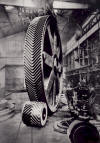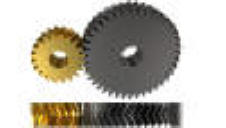| Type of Gears -
Herringbone Gears |
|
Video |
| A herringbone gear, also
known as a double helical gear, is a gear that combines two helical
gears of opposite hands, placed side-by-side. The teeth are arranged in
a "V" shape, resembling the bones of a fish. This unique design allows
it to transmit power smoothly and with less noise than other types of
gears. |
| |
| Key features and
advantages: |
- Neutralized axial
thrust: A key feature of herringbone gears is that the opposing
axial thrust forces from each helical half cancel each other out.
This eliminates the need for large, costly thrust bearings, which
are necessary for single helical gears.
- High load capacity:
With a larger contact area due to multiple teeth meshing at once,
herringbone gears can distribute the workload more evenly. This
allows them to handle significantly higher loads and torque than
spur gears.
- Smooth and quiet
operation: The gradual engagement of the angled teeth results in
smooth power transmission with reduced vibration and noise, making
them ideal for high-speed applications where quiet operation is
critical.
Improved lubrication: The V-shape of the teeth helps promote better
oil flow, which ensures more effective lubrication between the gear
surfaces.
- Strength and
reliability: The design's strength and stability make herringbone
gears particularly well-suited for demanding, heavy-duty
applications.
|
| Disadvantages |
- Manufacturing
complexity: Herringbone gears are difficult and expensive to
manufacture, as standard gear hobbing machines cannot be used due to
the continuous V-shape of the teeth.
- Specialized
processes: They require slower and more specialized processes like
gear shaping.
Assembly issues: When assembled from two separate helical gears,
errors can occur during joining, which reduces the efficiency and
optimal contact pattern.
- Lower accuracy:
Because of the complex manufacturing and assembly, herringbone gears
can have lower accuracy, particularly in comparison to gears with
simpler designs.
- Bulkier design: The
manufacturing process often requires a central groove or a wider
face width, making the gears physically wider than single-helical
gears, which can be a problem for space-constrained applications
like automotive transmissions.
- Lower efficiency:
While they eliminate axial thrust, assembly errors can sometimes
lead to lower overall efficiency compared to an ideal gear.
Not ideal for all applications: Due to their complexity, they are
not as productive and are often limited to applications where their
unique benefits, such as zero axial thrust, are most needed, like
heavy machinery.
|
|
|



